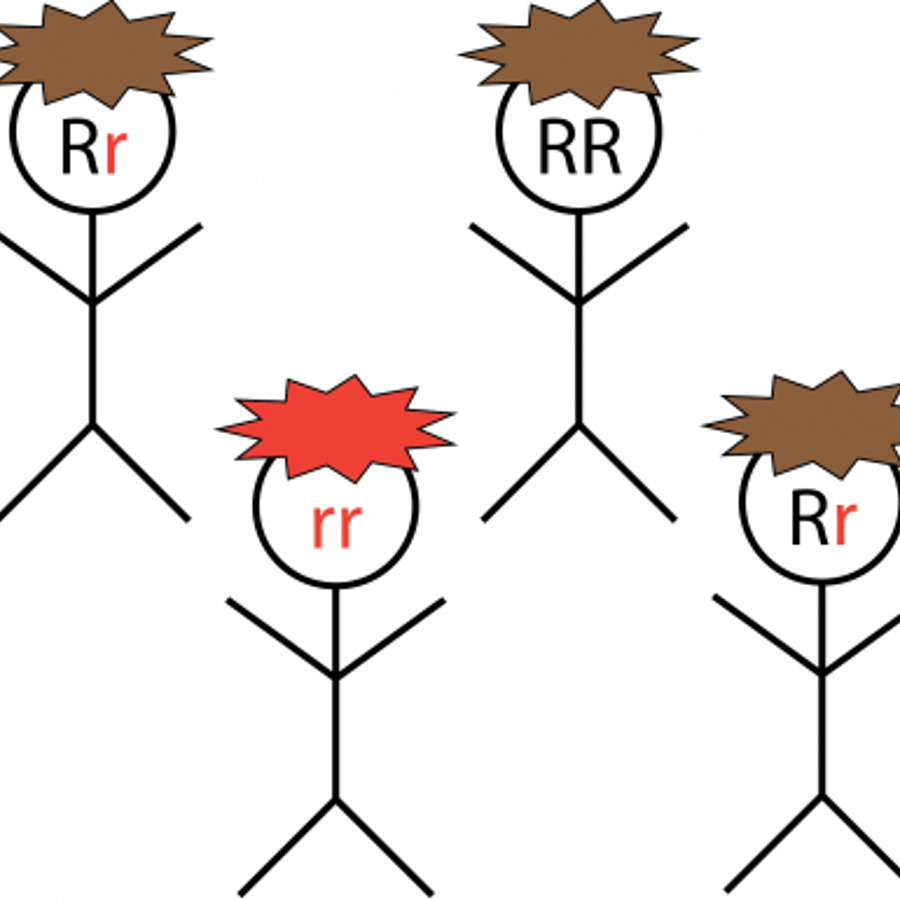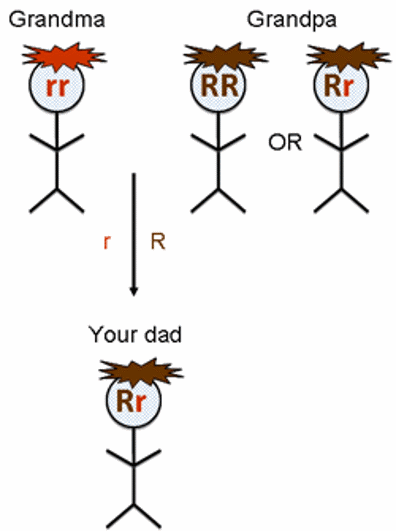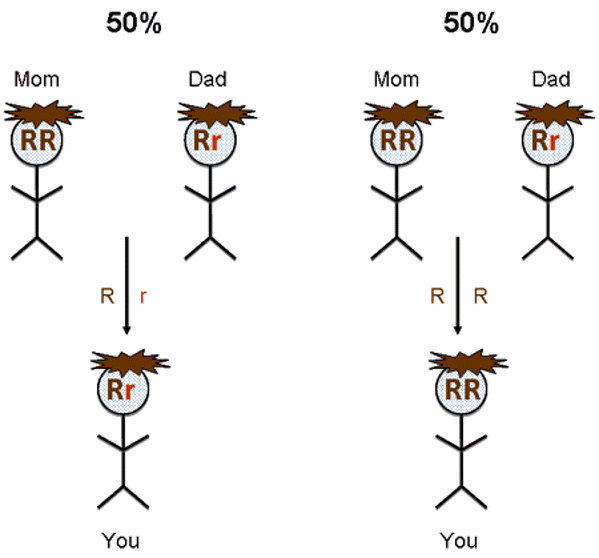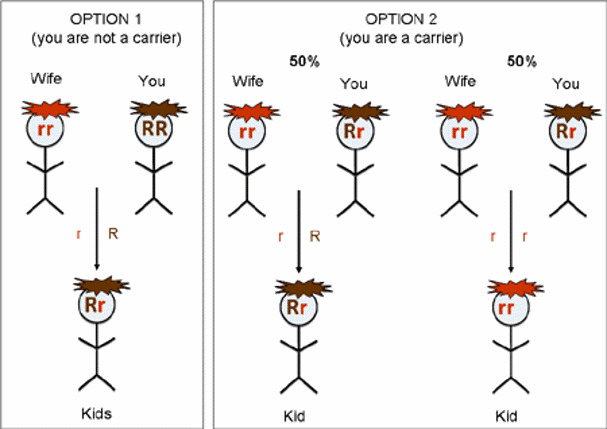
My wife has red hair, and my grandma did too. Could we have a redhead?
November 27, 2012

- Related Topics:
- Hair color,
- Red hair,
- Pigmentation traits,
- Carrier,
- Dominant and recessive
A curious adult from California asks:
"My grandma on my dad’s side had red hair and so does my wife. What are our chances of having a redhead?"
This isn’t as easy to answer as our last red hair question. What I can say is that your kids either have around a 50% chance for red hair or pretty close to no chance. It all depends on whether or not your grandma’s red hair gene got passed through your parent to you or not.
If you were to look up something like this online, you’d probably end up finding the average, 25%. Spread out over a big population this is true but it doesn’t work as well in individual cases.
You either have a red hair gene to pass down or you don’t. In your case, if you have a red hair gene, then your kids have a 50% chance at red hair. If not, then odds are none of your kids will have red hair.
This is why we need to be so careful of the percent risks we read about online. They are averages and may have nothing to do with you specifically.
For example, the average man has a 1 in 6 chance of getting prostate cancer but your average could be much higher or lower than that. It all depends on your specific set of genes. The same thing is true in this case for red hair.
What I’ll do for the rest of the answer is talk about why your kids have either a 50% or no chance for having red hair. You’ll see it depends on whether your dad passed a red hair gene to you or not.
(For those of you who read the answer from a couple of weeks ago, you can feel free to skip the next section. It is copy and pasted from that answer since I didn’t want to rewrite the same information in a slightly different way!)
Crouching Traits, Hidden Versions
Genes are pieces of DNA that each have the instructions for one small part of you. So there is a gene that determines whether or not you’ll have brown eyes, another that determines green eyes, still another that determines whether or not you’ll have red hair and so on for each of your other 20,000 or so genes. It is the red hair gene we are obviously interested in here.
The key gene involved in red hair is called MC1R. It comes in two versions that we will call "not-red" and "red." For reasons that I’ll explain in a bit, I’ll call the not-red version R and the red version r.
We all have two sets of most of our genes — one set from mom and the other from dad. This means we have two copies of the MC1R gene too.
So we have two copies of the MC1R gene and it comes in two versions. Here are the three possible combinations of MC1R genes:
|
RR |
|
|
Rr |
|
|
rr |
|
Remembering that R means not red and r means red, two of these three combinations are easy to figure out. RR would mean not red and rr would mean red. But what about Rr?
Turns out Rr almost never has red hair (although they can have red highlights). This is because the R version of the MC1R gene is dominant over the recessive r version. R beats out r and so an Rr person does not have red hair. (In genetics, a capital letter means the dominant or winning version and a lower case letter means the recessive version.)
With this information, we can fill in our table like so:
|
RR |
Not red |
|
Rr |
Not red |
|
rr |
Red |
We need just one more bit of information to figure out the chances that your kids will have red hair. That final piece is that when we have kids, we pass just one of our copies down. And that this copy is chosen at random. (Well, I guess there were two bits of information!)
So for example, an Rr person has a 50% chance of passing down an R and a 50% chance of passing down an r each time he or she has a child. This is where your 50% comes from.
50 or 0
Ok, so now we have the background to figure out you and your wife’s red hair genes. Let’s do it.
Your wife’s case is an easy one. Since she has red hair, she probably has two copies of the red hair version, r. She is most likely rr.
Your case is a bit trickier though. To do that, we need to first figure out what genes your parents had.
Your grandma had red hair which means she is rr. This also means that she passed an r down to your dad (that is all she had to give).
Since your dad didn’t have red hair, we know that he has the not-red version, R, too. He is Rr, a carrier of red hair.

This means you could have either got an R from your dad or an r. So you could be RR or Rr. Here is a picture of what I mean:
 (Note I am assuming your mother passed an R down to you. We don’t know this for sure and if she is a carrier for red hair, then that changes your chances of being a carrier.)
(Note I am assuming your mother passed an R down to you. We don’t know this for sure and if she is a carrier for red hair, then that changes your chances of being a carrier.)
If you are RR, then none of your kids will have red hair. They will get an R from you and an r from their mother. They will be Rr which means they usually won’t have red hair. This will be true for all of your kids because you can only give an R and your wife can only give an r.
But if you are a carrier (Rr), then your kids might have red hair. In this case, each of your kids has a 50% chance of getting an R from you and a 50% chance of getting r. Because your wife will pass an r every time, this means each of your kids has a 50% chance for red hair (rr) and a 50% chance at not having red hair (Rr). Here it is in all its gory details:

This is where the 0% and the 50% numbers came from. If you ended up a carrier, each child has a 50% chance. If your dad passed you an R instead, then none of your kids will have red hair.
But all of your kids will be carriers for red hair. Which means that if they marry the right person, you could have red haired grandchildren in your future.
Your situation is actually similar to my own. My grandpa had red hair which he passed to his son, my dad. My dad passed the red hair version of MC1R down to me which I passed down to two of my three kids.
Our situation is different because my wife doesn’t have red hair. But since her mom had red hair, we know she is a carrier too. And one of our kids got a red hair version from each of us and so has red hair!

Author: Dr. D. Barry Starr
Barry served as The Tech Geneticist from 2002-2018. He founded Ask-a-Geneticist, answered thousands of questions submitted by people from all around the world, and oversaw and edited all articles published during his tenure. AAG is part of the Stanford at The Tech program, which brings Stanford scientists to The Tech to answer questions for this site, as well as to run science activities with visitors at The Tech Interactive in downtown San Jose.
 Skip Navigation
Skip Navigation
